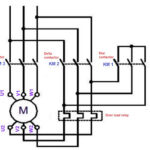V/F Ratio in Variable Frequency Drives (VFDs)
Variable Frequency Drives (VFDs) are extensively used in industrial and commercial applications to control the speed and torque of AC induction motors.
One of the fundamental concepts that underpin the efficient operation of VFDs is the V/F ratio—the ratio of voltage (V) to frequency (F) applied to the motor.
This article explains the V/F ratio and why it is so crucial in VFD operation?
What is the V/F Ratio?
The V/F ratio refers to maintaining a proportional relationship between the output voltage and the output frequency of the VFD supplied to the motor.
In simpler terms, as the frequency supplied to the motor changes to control its speed, the voltage is adjusted in the same proportion.
For example, if the frequency drops to half of its rated value, the voltage is also reduced to half, thus maintaining a constant ratio.
Why is Maintaining a Constant V/F Ratio Important?
The primary reason for maintaining a constant V/F ratio lies in controlling the magnetic flux within the motor.
When alternating current is applied to the stator winding of the motor, it generates a rotating magnetic field that induces flux in the motor core.
Φ = Φm Sinωt
e = – N (dΦ/dt)
e = – N [(dΦm Sinωt/dt)]
e = – NωΦm Cosωt
e = 2πfN Φm Cosωt
e = Em Cosωt
Em = 2πfN Φm
Vrms induced voltage;
erms = Em/√2
erms = (2πfN Φm) /√2
erms = 4.44 Φm f N
Φ = erms / 4.44 f NΦm
Φ =e/f = v/f
The magnitude of this flux is directly proportional to the ratio of voltage to frequency.
If the voltage does not change proportionally with frequency, the flux will either increase or decrease beyond safe operating limits:
If voltage remains too high at a low frequency, the motor flux increases excessively, causing magnetic saturation.
This leads to higher eddy current and hysteresis losses, excessive heating, and potential damage to the motor insulation.
If voltage is too low for a given frequency, the motor flux weakens, resulting in lower torque and poor motor performance.
Therefore, maintaining a constant V/F ratio ensures that the motor flux stays near its rated value, preventing damage and optimizing efficiency.
How Does the VFD Maintain the V/F Ratio?
The VFD uses a Pulse Width Modulation (PWM) inverter to adjust the output voltage in proportion to the output frequency.
For example, if a motor is rated at 440 volts and 50 Hz, operating it at 25 Hz would require the voltage to be adjusted to 220 volts to maintain the V/F ratio.
The VFD automatically regulates these parameters to keep the motor operating within safe flux limits.
Operating Regions and Limitations
Up to the rated motor speed (base speed), the motor runs with a constant torque because the V/F ratio is maintained continuously.
Above the rated speed, the VFD cannot increase the voltage beyond the motor’s maximum voltage rating. As a result, the flux starts to decrease, leading to a reduction in torque. This region is known as the field weakening region where the motor operates at constant power but reduced torque.
Applications and Advantages
Maintaining a constant V/F ratio allows VFDs to provide smooth and energy-efficient speed control for many applications such as pumps, fans, and conveyors. It is a simple yet effective control method that helps prolong motor life and reduce energy consumption.
